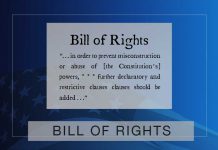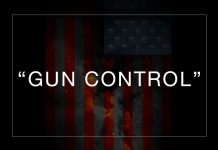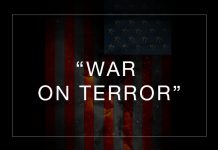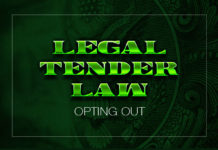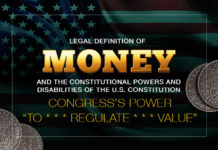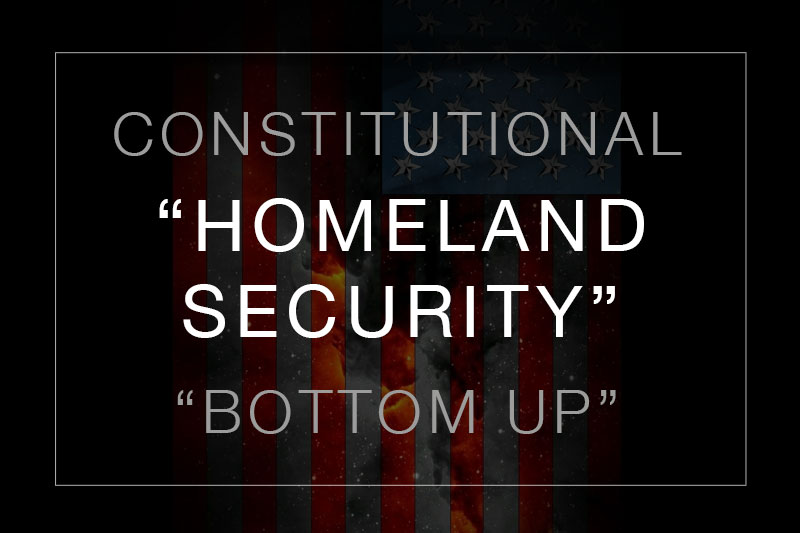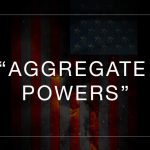Last Updated on April 1, 2021 by Constitutional Militia
II. A Critical Analysis of Abood v. Detroit Board of Education
To understand the centrality of Abood[19] to the Supreme Court’s twisted trail of duplicity through the forest of public-sector collective bargaining requires review of the leading private-sector compulsory-unionism cases preceding Abood, and on which Abood purported to rely: Hanson[20] and Street.[21] For, prior to Abood, the Court had never heard a case involving any aspect of public-sector bargaining.
Hanson, Street and Other Decisions Preceding Abood
At issue in Hanson was the constitutionality of the “union-shop” provision of the private-sector Railway Labor Act.[22] The complaining employees argued that the Act’s requirement that they pay “periodic dues, initiation fees, and assessments” to unions violated the Due Process Clause of the Fifth Amendment. As the Court (per Justice Douglas) described their claim, “[i]t is said that the right to work, which the Court has frequently included in the concept of ‘liberty’ within the meaning of the Due Process Clause … may not be denied by the Congress.”[23] To this, the Court responded that Congress has the power “[t]o require, rather than to induce, the beneficiaries of trade unionism to contribute to its costs,” because “Congress might well believe that it would help insure the right to work in and along the arteries of interstate commerce.”[24]
The “liberty” under the Due Process Clause to which Justice Douglas referred–the only constitutional right mentioned in the portion of Hanson upholding the payment of compulsory dues for collective bargaining–was not then, and is not now, always synonymous with First-Amendment freedoms; and when referred specifically to the “right to work” had never, prior to Hanson, been thought (let alone held) to come within the ambit of, or to implicate, those freedoms. Moreover, Hanson’s speculative language “Congress might well believe” was typical of the type of loose “rational-basis” reasoning that the Court had traditionally employed (and still uses) in cases not involving such so-called “fundamental” rights as those the First Amendment protects.[25] So, beyond question is that the Court did not decide that the requirement of financial support for collective bargaining itself does not violate the First Amendment.
The Court then noted that, although “[w]ide-ranged problems are tendered under the First Amendment” with respect to employees’ freedoms of association, conscience, and thought,
[o]n the present record, there is no more an infringement or impairment of First Amendment rights than there would be in the case of a lawyer who by state law is required to be a member of an integrated bar. It is argued that compulsory [union] membership will be used to impair freedom of expression. But that problem is not presented by this record. … If … the exaction of dues, initiation fees, or assessments is used as a cover for forcing ideological conformity or other action in contravention of the First Amendment, this judgment will not prejudice the decision in that case.[26]
Of course, later on in Lathrop v. Donohue,[27] when squarely faced with the question of the constitutionality of compulsory membership in “an integrated bar,” Justice Douglas professed to see things through a different glass: “In the Hanson case we said, to be sure, that if a lawyer could be required to join an integrated bar, an employee could be compelled to join a union shop. But on reflection the analogy fails.”[28] Too bad that Douglas had not engaged in more “reflection” when he wrote Hanson. Nevertheless, in Lathrop he did dimly envision the future consequences of his own past handiwork in Hanson:
Once we approve this measure [i.e., the integrated bar], we sanction a device where men and women in almost any profession or calling can be at least partially regimented behind causes which they oppose. I look on the Hanson case as a narrow exception to be closely confined. Unless we so treat it, we practically give carte blanche to any legislature to put at least professional people into goose-stepping brigades.[29]
That is, to dragoon tens of millions of mere employees “into goose-stepping brigades” was a “narrow,” albeit to Douglas quite acceptable, “exception” to the First Amendment. But to force lawyers and other “professional people” to march in ideological lockstep was beyond the pale! The crass elitism of this attitude hardly needs emphasis.
Justice Douglas’s tardy confession of misjudgment is but another, if telling, example of the old adage that “we grow too soon old and too late smart.” As his belated mea culpa in Lathrop showed, Douglas was a myopic jurist if ever there was one, forgetting what the Court had previously observed:
“A wrong decision does not end with itself; it is a precedent, and, with the swing of sentiment, its bad influence may run from one extremity of the arc to the other.”[30] [O]nce a judicial opinion rationalizes [a governmental act] to show that it conforms to the Constitution, or rather rationalizes the Constitution to show that the Constitution sanctions such an [act], the Court for all time has validated the principle … The principle then lies about like a loaded weapon ready for the hand of any authority that can bring forward a plausible claim of an urgent need. Every repetition imbeds the principle more deeply in our law and thinking and expands it to new purposes. All who observe the work of courts are familiar with … ‘the tendency of a principle to expand itself to the limit of its logic.’ … [I]f we review and approve, [a] passing incident becomes the doctrine of the Constitution. There it has a generative power of its own, and all that it creates will be in its own image.[31]
Unfortunately, Justice Douglas’s gloomy prediction came to its poisonous fruition for “professional people” (college faculty) in Knight II through this sequence: Hanson, then Abood (which deceitfully relied on Hanson), Knight I (which deceitfully relied on Abood), and Knight II (which deceitfully relied on Knight I). This is proof positive that the floors of the Judiciary’s no-doubt expansive corner of Hell are paved with all those “narrow exception[s]” that some judges foolishly hoped would be “closely confined,” but then, like dragons’ teeth, turned out to have monstrous lives of their own.
Regarding the First Amendment, clearly the Hanson Court was talking about unions spending money primarily for political and ideological activities, not for collective bargaining. The employees before the Court in that case never argued that they had a First-Amendment right to speak to or associate with their employer as an aspect of their employment relationship, or that their First-Amendment rights were abridged because the statute required them not to speak to their employer, but instead to pay an exclusive representative to speak “for” them, in the course of that relationship.
So, when Hanson ultimately concluded that “[w]e hold only that the requirement for financial support of the collective bargaining agency by all who receive the benefit of its work is within the power of Congress under the Commerce Clause and does not violate either the First or the Fifth Amendments,“[32] it was combining in one phrase two entirely separate parts of its opinion: the first, that “[t]o require, rather than to induce, the beneficiaries of trade unionism to contribute to its cost” did not violate the Fifth Amendment’s Due Process Clause with respect to the “right to work” subsumed within the concept of “liberty” (the issue squarely presented in the record);[33] the second, that, although “[i]t is argued that compulsory membership will be used to impair freedom of expression [outside of collective bargaining],” “that problem is not presented by this record,” and the statute on its face does not violate the First Amendment in that respect.[34]
Of course, even Hanson’s holding that “[t]o require, rather than to induce, the beneficiaries of trade unionism to contribute to its cost” did not violate the Fifth Amendment was grounded in the rankest speculation, rather than proven facts. For Justice Douglas’s notion that “[o]ne would have to be blind to history to assert that trade unionism did not enhance and strengthen the right to work”[35] was itself a controversial question that the litigation had not settled as a matter of legally admissible evidence–with respect to either the employees before the Court or anyone else.
Notwithstanding Douglas’s assertion, even the best economic analysis of that time clearly demonstrated that if unions achieve economic gains for the workers they represent, they do so generally at the expense of other workers, not of entrepreneurs and investors.[36] That is, to the extent it is economically successful at all, compulsory collective bargaining merely redistributes wealth among workers themselves, not between the false Marxian abstractions “labor” and “capital.” Moreover, even within a group of workers a union represents, material gains for some may come only at the expense of others–disproving for its own partisans the myth of “union solidarity” that “trade unionism … enhance[s] and strengthen[s] the right to work” for everyone. And finally, even for an employee who could be shown to gain materially from forced union representation, the “union-benefit” question ultimately reduces to a matter of philosophy or ideology, not economics. For such an economically fortunate employee could nonetheless oppose union representation on noneconomic grounds, and be willing to give up any material gains for the psychic benefit of being free from union control of his employment.
On what theory can Congress’s determination under the Commerce Clause that such an employee should be forced to accept mere material gain at the cost of philosophical freedom run roughshod over the First-Amendment’s guarantee that the government will not “make any person pay out one single penny against his will to be used in any way to advocate doctrines or views he is against, whether economic … or any other”?[37] And how much less plausible and constitutionally acceptable is Congress’s determination on that score, where it has not been shown that the affected employee does, in fact, obtain any material gain at the cost of his philosophical freedom; or where it might be shown that he actually suffers a material loss in addition to the loss of that freedom?
To be sure, the argument might have been made in Hanson, that to require employees to accept and finance a union as their exclusive representative for the purpose of speaking to their employer unconstitutionally imposes upon them conformity to the ideology of trade unionism, which would have raised a First-Amendment issue. Perhaps that argument might not have succeeded. For clearly the Court in Hanson was wedded to the unionist ideology, which it took for some kind of indisputable fact: “One would have to be blind to history to assert that trade unionism did not enhance and strengthen the right to work.”[38] And that ideology was just as clearly at the heart of the kind of exclusive representation the Court had belatedly read into the National Labor Relations and Railway Labor Acts in J.I. Case Co. v. NLRB,[39] and Order of Railroad Telegraphers v. Railway Express Agency, Inc.[40] For example, in applying exclusive representation to strike down individual contracts between employees and their employers, the Court, in J.I. Case, rationalized its decision on the theory that “[t]he practice and philosophy of collective bargaining looks [sic] with suspicion on … individual advantages.”[41] Moreover, when Hansonwas decided, whether the Supreme Court would have held private-sector business-related communications between employees and their employers to be “free speech” subject to all the protections of the First Amendment was questionable.
On the other hand, the reasoning in Justice Black’s later dissent in Streetwould have supported the employees’ claim:
[T]he First Amendment bars use of dues extorted from an employee by law for the promotion of causes, doctrines and laws that unions generally favor to help the unions, as well as any other political purposes. … [W]orkers have as much right to their own views about matters affecting unions as they have to views about matters in the fields of politics and economics. Indeed, some of their most strongly held views are apt to be precisely on the subject of unions ….[42]
The italicized language obviously would apply to compulsory collective bargaining through exclusive representation as: “causes” or “doctrines … that unions generally favor to help the unions”; “matters affecting unions”; “matters … in the field[ ] of … economics”; and a subject on which employees have “strongly held views.” Black might not have wanted to apply his own reasoning to compulsory fees used for collective bargaining, because he too believed that Congress could “constitutionally authorize … a worker to pay dues to a union for the sole purpose of defraying the cost of acting as his bargaining agent.”[43] But, had the argument been made, he would at least have been confronted with the glaring anomaly in his own thinking.
In any event, the employees before the Court in Hanson did not contend that the “union shop” was unconstitutional under the First Amendment because it infringed upon their freedom to speak with their employer. For that reason, Hanson did not address, and could not have addressed, that question. And, therefore, as Hanson purported to promise, “[i]f … the exaction of dues, initiation fees, or assessments is used as a cover for forcing ideological conformity or other action in contravention of the First Amendment, this judgment will not prejudice the decision in that case.”[44] That is, Hanson left open the question of whether a “union-shop,” “agency-shop,” or “fair-share” scheme that compelled employees to remain silent and to finance speech on such matters (via statutorily imposed payments to exclusive representatives through the employer) was unconstitutional. Thus, the decision was not a constitutional precedent, one way or the other.
At issue in Street, too, was the legality of private-sector unions’ expenditures of “union-shop” fees for activities (again, primarily political and ideological) other than collective bargaining. Rather than deciding a constitutional question, though, the Court ruled solely as a matter of statutory construction that the Railway Labor Act did not allow unions to spend compulsory fees on political and ideological causes to which employees objected.[45] Thus, even more so than did Hanson, Street left open the question of whether–where dissenting employees had a clear-cut First-Amendment right to speak to their employers about matters related to their employment–a “union-shop,” “agency-shop,” or “fair-share” scheme that compelled those employees to finance speech on such matters to the employer by the employees’ exclusive representatives was unconstitutional vel non.
The Abood Decision
Abood then set Hanson and Street on their heads. Squarely at issue in Abood was the constitutionality of the “agency-fee” provision of Michigan’s public-employment labor-relations law. Thus, central to Abood was an unavoidable First-Amendment question turning on two undeniable distinctions between private and public employment: namely, (i) that in government employment any interference in the relationship between employer and employee arguably impacting speech, association, and (derivatively) petition necessarily raises a First-Amendment issue; and (ii) that because governmental employment is part and parcel of the political process, therefore public-sector collective bargaining itself is inherently political in nature. Moreover, by the time of Abood, the Court had settled on its “compelling-state-interest” and “least-restrictive-alternative” tests for deciding First-Amendment questions–strict standards that went far beyond the jurisprudence of Hanson’s era.[46]
Rather than addressing these issues on their own merits, the Abood Court (per Justice Stewart) fell back on Hanson and Street, which he described as “two cases … that on their face go far toward resolving the issue.”[47] Inasmuch as Street decided no constitutional issue at all, it can be disregarded–except to observe that Justice Stewart used that non-constitutional precedent in a case squarely raising constitutional issues, which is darkly suspicious. However, Justice Stewart treated Hanson as a true precedent, saying that “the [Hanson] Court squarely held that ‘the requirement for financial support of the collective-bargaining agency by all who receive the benefits of its work … does not violate … the First … Amendmen[t].'”[48]
The patent deceit in this statement, of course, lies within the carefully crafted emptiness of the ellipses. For, as explained above, Hanson never held that compulsory “financial support of the collective-bargaining agency” itself did not violate the First Amendment. Hanson held only that such compulsory financial support did not violate the “right to work” included within the “liberty” protected by the Due Process Clause. And Hanson constructed that holding on mere “rational-basis” grounds, not on grounds justifying abridgment of First-Amendment rights even under the cloudy and lax judicial tests in vogue when Hanson was decided, let alone the far more rigorous tests the courts applied by the time Abood came up for review. Moreover, Hanson addressed only the issue of “financial support of the collective-bargaining agency,” not the constitutionality vel non of the union’s status as exclusive representative that rationalized coercion of any “financial support” from dissenting employees.
Revealingly, Justice Stewart admitted that the nonunion teachers in Abood had advance[d] two reasons why [Hanson and Street] should not control decision of [Abood]. First … that government employment … is involved in [Abood], thus directly implicating constitutional guarantees, in contrast to the private employment that was the subject of the Hanson and Street decisions. Second … that in the public sector collective bargaining itself is inherently “political,” and that to require the [teachers] to give financial support to [the union] is to require the “ideological conformity” that the Court expressly found absent in the Hanson case.[49]
Justice Stewart, however, rejected these arguments. To the first, he responded that,
the union shop, as authorized by the Railway Labor Act, also was found to result from governmental action in Hanson,. The plaintiffs’ claims in Hanson failed, not because there was no governmental action, but because there was no First Amendment violation.[50]
This purported explanation of Hanson is exceptionally thin hogwash. That there was “governmental action” in Hanson went to the question of whether the “union shop” abridged the “right to work” included in the “liberty” protected by the Due Process Clause. Had there been no “governmental action,” there could have been no arguable violation of the Due Process Clause–and no reason for the Hanson Court to opine on that issue at all. But that there was “governmental action” did not mean that a specific First-Amendment issue was necessarily litigated. Indeed, one can read the portion of Hanson dealing with “liberty,” the “right to work,” and due process without once finding the words “First Amendment,” “freedom of speech,” or (more importantly in Abood, where the government is the employer) “freedom of petition,” or any reference or even allusion to those concepts.[51]
This is hardly surprising, though, inasmuch as the Hanson Court found “governmental action” in the Railway Labor Act’s preemption of State laws–that is, under a Commerce-Clause, not a First-Amendment, theory.[52] Thus, the employees’ “claims in Hanson failed,” not because the Court ruled that the “union shop” did not violate the First Amendment as to monies paid for collective bargaining, but because the Court ruled that the “union shop” did not violate the Due Process Clause, and said nothing whatsoever about the First Amendment on that score.
Rejecting the Abood teachers’ second argument, Justice Stewart catalogued some of what he called “the important and oft-noted differences in the nature of collective bargaining in the public and private sectors.”[53] Most of these were economic in character, and in any event did not relate to the teachers’ specific constitutional contentions. The important point, which Justice Stewart acknowledged, was that
decisionmaking by a public employer is above all a political process. … [P]ermitting public employees to unionize and a union to bargain as their exclusive representative gives the employees more influence in the decisionmaking process than is possessed by employees similarly situated in the private sector.[54]
That insight should have led Justice Stewart to conclude that compulsory public-sector bargaining–which, as part of the process of “decisionmaking by a public employer,” must also be part of the “political process”–imposes political conformity on nonunion employees (who must accept the political decisions their exclusive representative make in collective bargaining). Moreover, it imparts a disproportionate amount of political influence to union members (or, more realistically, to their leaders)–not only as against “employees similarly situated in the private sector,” but also as against nonunion public employees, taxpayers, voters, and everyone else among the general public.
Then Justice Stewart should have asked the question: On what possible theories of political equality and free speech could one group of employees (nonunion teachers) be required to subsidize the political activity of another group (union members), even if the first group arguably received from that subsidization some economic benefit for which they had never asked, which they were willing to forego, and which resulted from a political detriment imposed on them?
Rather than answering (or even admitting the existence of) this pregnant question, which lays out the basic and unavoidable conflict between compulsory public-sector collective bargaining and representative government,[55] Justice Stewart artfully shifted his ground, opining that,
public employees are not basically different from private employees; on the whole, they have the same sort of skills, the same needs, and seek the same advantages. “The uniqueness of public employment is not in the employees nor in the work performed; the uniqueness is in the special character of the employer.” The very real differences between exclusive-agent collective bargaining in the public and private sectors are not such as to work any greater infringement upon the First Amendment interests of public employees.[56]
On its face, this passage contradicted the passage in which Justice Stewart admitted that “decision making by a public employer is above all a political process.” No collective bargaining in the private sector is political–and, therefore, compulsory collective bargaining in that arena can never impose political conformity or political inequality. Whereas, all collective bargaining in the public sector is political–and, for that reason, all compulsory collective bargaining there imposes such conformity and inequality as a necessary consequence of its normal operation.[57] (And even voluntary public-sector collective bargaining would result in political inequality between union members, on the one side, and everyone else in society, on the other.) Perhaps one can argue that imposed political conformity and inequality ought to be deemed constitutional in public employment to achieve some “greater good”–but one cannot gainsay that such conformity and inequality are present in public-sector bargaining in a way they can never be in the private sector.
Justice Stewart conceded that
(t)here can be no quarrel with the truism that because public employee unions attempt to influence governmental policymaking, their activities–and the views of members who disagree with them–may be properly termed political. But that characterization does not raise the ideas and beliefs of public employees onto a higher plane than the ideas and beliefs of private employees.[58]
That, however, was neither the issue in Abood, nor a bridge spanning the gulf that separates Hanson from Abood. The Abood teachers did not argue (or even intimate) that “the ideas and beliefs of public employees [occupy] a higher plane than the ideas and beliefs of private employees.” Rather, the Abood teachers contended that “the ideas and beliefs of public employees” (that is, themselves) were being infringed by compulsory public-sector bargaining in a way that “the ideas and beliefs of private employees” had not been and could not be (and were not argued in Hanson to have been) infringed by compulsory private-sector bargaining.
Contrary to Justice Stewart’s notions, public employees do enjoy rights quite different from private employees. For instance, in the absence of a statute outlawing discrimination, a private employer could refuse to hire practitioners of one religion, or members of one political party; but, even without such a statute, the Constitution prohibits a public employer from doing so. This does not signify that the religious or political beliefs of public employees are “raise[d] … onto a higher plane than the … beliefs of private employees,” but instead reflects that, absent a statute, public employers,enjoy less power than private employers to control the terms and conditions of their employees’ hire and tenure. And less power for one group of employers necessarily entails more (or enlarged) rights for their employees.
Had Hanson ruled that private-sector trade unionism constitutes an ideology, that private-sector compulsory collective bargaining imposes ideological beliefs on nonunion employees, and that nevertheless such bargaining is constitutional under the First Amendment, then, substituting “political” for “ideological,” Hanson would have been a precedent relevant to, although not necessarily controlling in, Abood. Even so, Hanson would not have been controlling because public-sector bargaining also imposes political inequality on nonunion public employees, taxpayers, voters, and others, and undermines democratic institutions, which private-sector bargaining does not and can not do.
Nevertheless, Hanson said none of this. And even if it could be read to imply that trade unionism constitutes an ideology, it cannot possibly be read to have employed the constitutional tests appropriate where First-Amendment freedoms from ideological compulsion are concerned (i.e., compelling state interest and least-restrictive alternative). Therefore, it could not be a precedent in a later true First-Amendment case where those tests (not Hanson’s vague verbiage) were controlling.
As Justice Stewart argued, compulsory public-sector collective bargaining does not prevent a nonunion public employee from “voting”; from “express[ing] his views, in public or in private orally or in writing”; or from “participating in the full range of political activities open to other citizens.”[59] But the constitutional question is not what other First Amendment political freedoms nonunion employees can exercise equally elsewhere or in other manners, but what political conformity and inequality they must suffer in, through, and because of the collective bargaining process.
Thus, Justice Stewart was disingenuous to conclude that “Hanson and Street [are] controlling in [Abood] insofar as the service charges are applied to collective-bargaining, contract administration, and grievance-adjustment purposes.”[60] It would have been one thing for Justice Stewart to admit that Hanson was not “controlling” because it was a private-sector case that did not adjudicate any First Amendment rights, and that therefore Abood was a case of first impression, and then to rule on the basis of some cockamamie theory that compulsory political conformity and inequality are constitutional in public employment. (That he did not is fairly convincing evidence that even he could not jury rig such a theory.) But it was deceptive at best to say that Abood was “controll[ed]” by Hanson, let alone by Street. Indeed, it was simply Justice Stewart’s way of shifting responsibility to a previous Court for whatever ill might come out of a judicial whitewashing of compulsory public-sector collective bargaining–a variant of “The Devil made me do it!” apology for wrongdoing, with Justice Douglas implicitly cast as Lucifer.
As Justice Powell noted wryly in Abood,
(o)ne would think that acceptance of th[e] principle [that the State infringes interests protected by the First Amendment when it compels an individual to support the political activities of others as a condition of employment] would require a careful inquiry into the constitutional interests at stake in a case of this importance. But the Court avoids such an inquiry on the ground that it is foreclosed by this Court’s decisions in … Hanson … and … Street….[61]
But, he concluded rightly,
(b)ecause neither Hanson nor Street confronted the kind of governmental participation in the agency shop that is involved [in Abood], those cases provide little or no guidance for the constitutional issues presented in this case.[62]
* * * * *
Under First Amendment principles that have become settled since Hanson and Street were decided, it is now clear, first, that any withholding of financial support for a public-sector union is within the protection of the First Amendment; and, second, that the State should bear the burden of proving that any union dues or fees that it requires of nonunion employees are needed to serve paramount governmental interests.[63]
Justice Powell might have added that there was no showing in Abood that the “agency shop” was the least-restrictive alternative to whatever “paramount governmental interests” compulsory collective bargaining supposedly served. But when the Abood teachers, in their petition for rehearing, pointed out this demerit in the Court’s opinion, neither Justice Powell nor any other Justice bothered to do anything about it.[64] So here one confronts another clear-cut example of the judicial pot calling the judicial kettle black.
Observe that what Justice Powell rightly accused Justice Stewart of doing–that is, avoiding adjudication under strict First-Amendment standards through the use of inapposite “precedent” and double-talk–is exactly what the Court (including Justice Powell himself) did sub silentio in Abood, on the teachers’ petition for rehearing. And what the Court (again, including Justice Powell) did sub silentio in Knight I, as interpreted by Knight II. And what Justice Brennan openly did in City of Madison, Perry, and Knight II to rationalize (rather than adjudicate) the constitutionality of exclusive representation. And what Justice Stevens (for the Court) did even more brazenly in Hudson to cover up what had been done in Knight I by falsely stating that Abood had upheld the constitutionality of exclusive representation in public-sector employment.[65]
So, from Hanson, through Abood and Knight I, to Hudson the chain of deceit became complete, and completely absurd. Abood falsely relied on Hanson and Street to uphold the “agency shop” in the public sector against a First-Amendment challenge, when Hanson and Street had not even upheld the “agency shop” in the private sector against such a challenge. Then Knight I (as interpreted by Knight II) falsely relied on Abood to uphold exclusive representation, when exclusive representation had not even been at issue in Abood. Then Hudson falsely characterized Abood as having upheld exclusive representation, leading logically to the false, if not utterly idiotic, conclusion that the precedents which Justice Stewart said “controll[ed]” Abood–Hanson and Street–had actually decided the constitutionality of exclusive representation![66]
For Part III click below.







